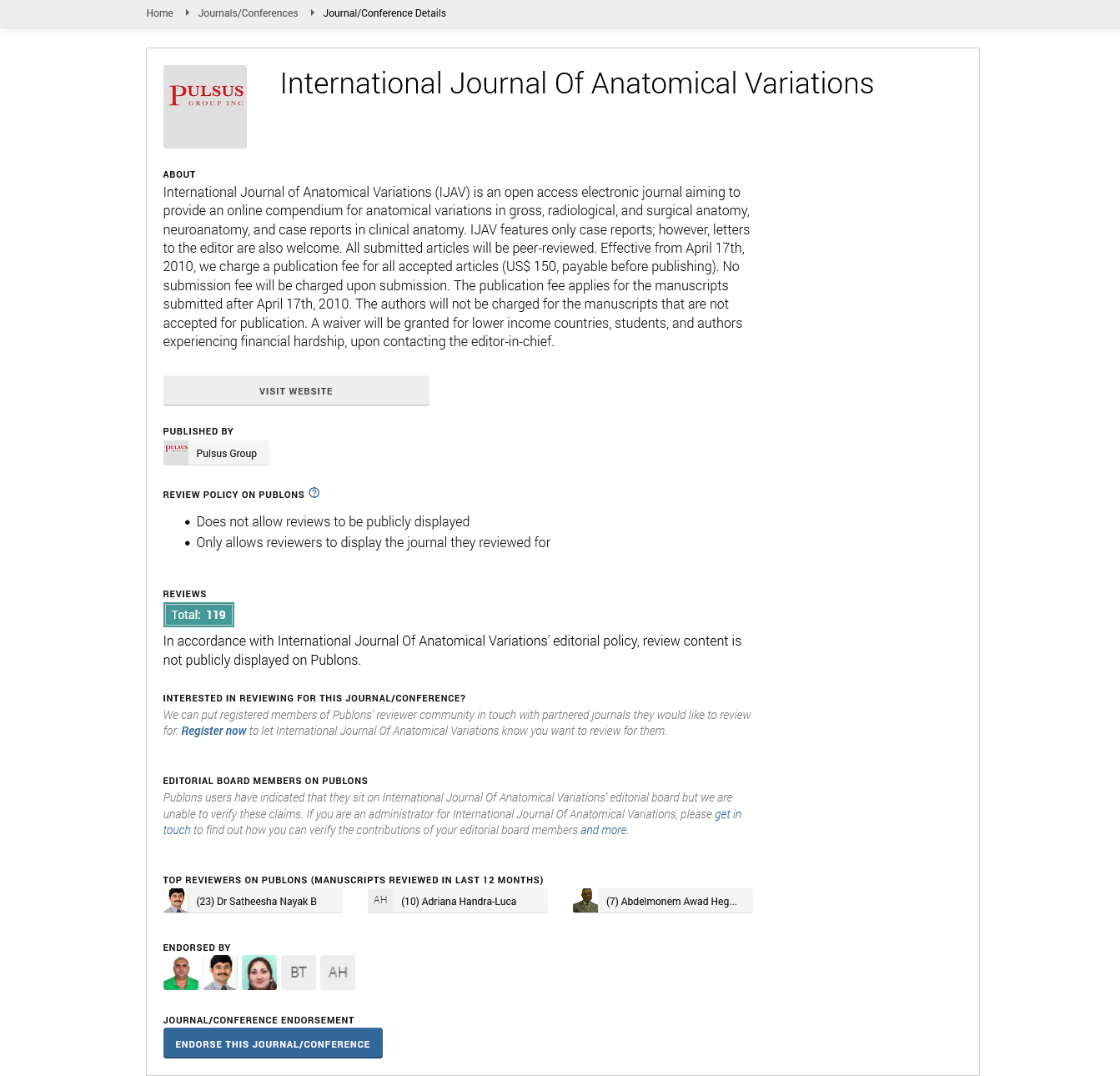Anatomical variations of superficial veins of the upper limbs
2 GABM, Undergraduate, Course of Medicine. Institute of Health Sciences. Federal University of Jataí (UFJ), Jataí, Goiás, Brazil
3 GFS, Specialization in Human Anatomy (Dissection, INEPG). Course of Medicine. Institute of Health Sciences. Universidade Federal de Jataí (UFJ), Jataí, Brazil
4 LCBSJ, MD, Mphil, Residency in Orthopaedics and Traumatology (FMTM). Course of Medicine. Institute of Health Sciences. Universidade Federal de Jataí (, Brazil
5 JRPG, PhD. Faculty of Medicine. University of Brasilia (UnB), Brasília, Federal District, Brazil
6 BLL, PhD. Faculty of Medicine. University of Brasilia (UnB), Brasília, Federal District, Brazil
Received: 11-Mar-2025, Manuscript No. ijav-25-7612; Editor assigned: 13-Mar-2025, Pre QC No. ijav-25-7612 (PQ); Reviewed: 26-Mar-2025 QC No. ijav-25-7612; Revised: 29-Mar-2025, Manuscript No. ijav-25-7612 (R); Published: 31-Mar-2025, DOI: 10.37532/1308-4038.18(3).491
Citation: Duarte PLS. Anatomical variations of superficial veins of the upper limbs. Int J Anat Var. 2025; 18(3): 731-733.
This open-access article is distributed under the terms of the Creative Commons Attribution Non-Commercial License (CC BY-NC) (http://creativecommons.org/licenses/by-nc/4.0/), which permits reuse, distribution and reproduction of the article, provided that the original work is properly cited and the reuse is restricted to noncommercial purposes. For commercial reuse, contact reprints@pulsus.com
Abstract
The cephalic, basilic, and median cubital veins constitute the superficial venous system of the upper extremity and are frequently utilized for vascular access procedures and medication administration. During a routine anatomical dissection, we observed an anatomical variation in the superficial venous pattern of the right upper extremity in a male dissected corpse. The notable variation included the absence of communication between the cephalic vein (CV) and basilic vein (BV) at the cubital fossa, coupled with the absence of both the intermediate vein of the forearm (IVF) and median cubital vein (MCV) in the superficial compartment. The basilic vein was observed traversing the basilic hiatus in the distal third of both upper extremities. In the contralateral upper limb, both the IVF and MCV were present in their typical anatomical positions. The identification of such venous anatomical variants through preoperative vein mapping is crucial for minimizing procedural complications and optimizing treatment outcomes.
Keywords
Cephalic vein; Basilic vein; Anatomical variation
INTRODUCTION
The cephalic vein (CV) functions to drain blood from the dorsal venous arch of the hand. It courses laterally through the forearm, receiving multiple tributary veins and connecting with the basilic vein (BV) via the middle vein of the elbow in the cubital fossa. In the arm, the cephalic vein runs lateral to the biceps, ultimately draining into the axillary vein at the clavipectoral triangle after passing beneath the clavicle and crossing the axillary artery [1-3]. The basilic vein follows a comparable course, originating in the dorsal hand capillary network and proceeding medially through the forearm after crossing the wrist. The intermediate elbow vein typically connects the cephalic and basilic veins. The basilic vein courses parallel to the deep brachial vein before their junction forms the axillary vein [4]. It typically traverses the basilic hiatus to reach the deep compartment in the distal third of the arm.
Embryologically, the cephalic vein develops distinctly from other upper limb superficial veins. While the basilic, axillary, and subclavian veins develop from ulnar plexus capillary fusion, the cephalic vein forms through anastomosis of the external jugular vein, which previously connected to the internal jugular vein. Subsequently, it drains via the axillary vein. During superficial vein embryological development, as capillary networks atrophy, the cephalic vein does not arise from radial plexus capillaries. Regional drainage is then managed by the cephalic vein and its tributaries [5, 6].
The cephalic vein holds significant clinical value for various medical procedures, including emergency hemodialysis, cardiac catheterization access, and venous cannulation [7]. It serves as a route for cardiac pacemaker and defibrillator placement [8, 9]. Its unique embryological development has led to documented anatomical variations in its termination. One such variation is its supraclavicular position, where it bifurcates at the clavipectoral triangle - one branch draining to the axillary vein and another to the external jugular. The smaller bifurcation branch consistently drains into the axillary vein bilaterally, with the right supraclavicular branch notably larger than the left [3].
Understanding these anatomical variations in the forearm, cubital fossa, and arm superficial veins is crucial for optimizing patient treatment and minimizing procedural errors [10]. This study aims to present a comprehensive literature review of upper limb venous anatomy and variations, focusing on the cephalic veins, to support discussion of a case study involving right upper limb superficial venous variation observed during routine cadaveric dissection at the Federal University of Jataí's Human Anatomy Laboratory.
CASE REPORT
Following approval from the Body Donation Program, a research protocol was established and subsequently approved by the local Ethics Committee (5.320.166) in accordance with Biorepository guidelines. Anatomical dissection workshops were conducted to document and publish observed anatomical variations.
The research methodology involved the preparation of a male cadaver through immersion in a 35% formalin fixative solution for a duration of two months. The upper limbs were systematically dissected, beginning with the removal of skin to expose superficial anatomical landmarks. Upon careful dissection of subcutaneous tissue and vessel cleaning, an atypical vascular pattern was identified in the right upper limb: the cephalic vein (CV) was observed to be isolated, lacking the typical connection with the basilic vein (BV), as documented in (Figures 1, 2). In contrast, the left upper limb exhibited the standard anatomical arrangement, with the median cubital vein (MCV) establishing the expected connection between the CV and BV. Both upper limbs demonstrated normal BV anatomy, with the vessel traversing the basilic hiatus in the distal third of the arm.
A comprehensive literature review was performed utilizing multiple electronic databases, including PubMed, Excerpta Medica (EMBASE), Lilacs/BIREME/BVS, and Mendeley. The search parameters encompassed studies published between 2018 and 2024, in both English and Portuguese languages. The search strategy employed Medical Subject Headings (MeSH) terms: "cephalic vein" AND "basilic vein" AND "anatomical variation." The observed anatomical variant was characterized by the absence of communication between the BV and CV at the cubital fossa level, where these vessels typically connect via the median cubital vein.
DISCUSSION
The principal superficial veins of the upper extremities - the cephalic and basilic veins - drain blood from the dorsal hand arches and course through the medial and lateral aspects of the upper limb. These vessels receive numerous tributaries and interconnect in the cubital fossa via the median cubital vein (MCV), ultimately joining the axillary vein at varying points depending on anatomical variation. The basilic vein (BV) exhibits three main anatomical variants related to brachial vein morphology and drainage patterns [1]. These variations include: 1) dual independent brachial veins with BV draining into the medial branch above the cubital region; 2) dual brachial veins with BV draining into the axillary vein proximal to the cephalic vein (CV) confluence; and 3) a duplicated brachial vein that becomes singular above the cubital region, with the BV draining centrally into the unified vessel below the CV [4].
Upper limb venous variations predominantly occur inferior to the cubital fossa. CV variations typically manifest as absence or presence of a small branch below the cubital fossa (CF). The CV's accessory nature below the CF suggests that BV branches and deep venous drainage can compensate for its absence [2, 3].
CV utilization for vascular grafting offers both economic and physiological advantages. Autologous accessory vein grafts are more cost-effective than prosthetic alternatives. While the great saphenous vein is commonly used, its removal may compromise lower limb venous drainage. CV grafting reduces, but does not eliminate, complications like aneurysm and thromboembolism [2].
A Malaysian study of 266 subjects demonstrated consistent variation patterns between sexes, with minimal bilateral differences [8]. The most common variant showed CV and BV traversing medially and laterally, connected by the cubital intermediate vein [8].
Literature reviews confirm bilateral CV presence in the deltopectoral sulcus and triangle [5, 4]. Though CV absence is rare, its occasional deep position can complicate catheterization procedures [5, 4].
The CV serves as an access route for cardiac device implantation, offering reduced pneumothorax risk [3]. One case report described anomalous CV drainage into the external jugular vein, necessitating alternative access via axillary puncture [3].
Anatomical dissection remains the gold standard for studying human anatomy and identifying variations relevant to clinical procedures [6].
While the CV is valuable for various procedures, other superficial veins may be utilized. Patient-specific evaluation is essential for determining the most appropriate vascular access [8].
CONCLUSION
Anatomical dissection represents the preeminent methodology for comprehending human anatomy and serves as an essential prerequisite for clinical education in healthcare professions. This practice facilitates the identification of anatomical variations that may significantly influence the outcomes of surgical interventions and therapeutic protocols. Understanding the configuration of superficial venous structures in the upper extremity is particularly crucial, as it directly impacts the development and management of chronic venous disorders in these anatomical regions. The diverse variations in upper extremity superficial venous anatomy necessitate meticulous planning for medical procedures, including venous access and emergency hemodialysis, to ensure optimal therapeutic outcomes. Furthermore, body donation programs serve a dual purpose: they advance research capabilities within Brazilian academic medical institutions while simultaneously enhancing the quality of medical education and professional training.
ACKNOWLEDGEMENT
The study was conducted in (a) the Medical Course of the Institute of Health Sciences of the Federal University of Jataí (UFJ), Jataí, Goiás. Brazil.
CONFLICTS OF INTEREST
The authors declare no conflict of interest in the accomplishment of this case report.
FUNDING
None.
APPROVAL OF THE ETHICS COMMITTEE
The research protocol was approved by the local ethics committee as a biorepository (approval number 5.320.166).
REFERENCES
- Saaid A, Drysdale I. Unusual termination of the cephalic vein. Clinical Anatomy 2008;21(8):786-787.
- Dogood AA, Aidemise OC. Variation in the Course and Termination of the Cephalic Vein in the Deltopectoral Triangle. Acta Facultatis Medicae Naissensis 2017;34(2): 99–105.
- Maalman RS, Donkor YO, Ayamba AM. A Rare Anatomical Variation of the Termination of Right and Left Cephalic Veins. Case Report Vascular Medicine 2018;21:5809656.
- Kusztal M, Weyde W, Letachowicz K. Anatomical vascular variations and practical implications for access creation on the upper limb. Journal of Vascular Access. 2014;15:S70-S75.
- Lum C. Ladenheim ED. An Interesting Clinical Case: Variant of the Cephalic Vein Emptying into the Internal Jugular Vein. Seminars in Dialysis. 2013;26(2):E11–E12.
- Araújo RC, Pires LAS, Andrade ML. Embryological and comparative description of the cephalic vein joining the external jugular vein: A case report. Morphologie. 2018;102(336):44-47.
- Matsuo M, Honma S, Sonomura T, Yamazaki M. Clinical anatomy of the cephalic vein for safe performance of venipuncture. Journal of Anatomical Clinical Reports 2017;3(1):50.
- Dharap AS, Shaharuddin MY. Patterns of superficial veins of the cubital fossa in Malays. Medical Journal of Malaysia 1994;49(3):239-241. DisponÃÂvel em:
- RamÃÂrez JD, Sáenz LC, RodrÃÂguez D, Restrepo AJ, Villegas F. Supraclavicular course of the cephalic vein. International Journal of Case Reports and Images 2014;5(4):281–284.
- Alves N. Formações venosas superficiais da fossa cubital: aspectos de interesse para a prática da Enfermagem. Revista Brasileira de Enfermagem 2012;65(6):1030-1033.
Indexed at, Google Scholar, Crossref
Indexed at, Google Scholar, Crossref
Indexed at, Google Scholar, Crossref
Indexed at, Google Scholar, Crossref
Indexed at, Google Scholar, Crossref
Indexed at, Google Scholar, Crossref
Indexed at, Google Scholar, Crossref








